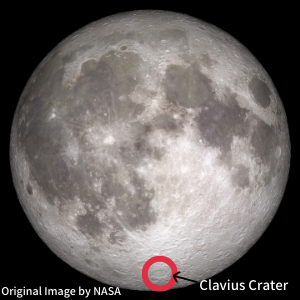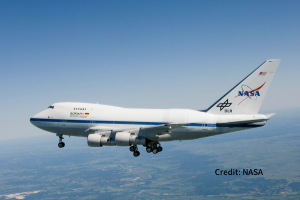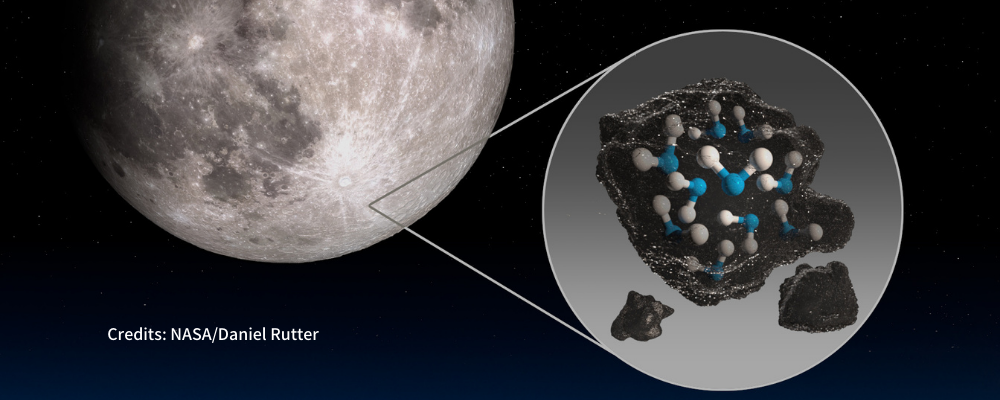NASA の空飛ぶ天文観測所 SOFIA -The Stratospheric Observatory For Infrared Astronomy- 成層圏赤外線天文台 による観測で、月の表面の日の当たる場所において水分子の存在を発見しました。
NASA’s SOFIA Discovers Water on Sunlit Surface of Moon
https://www.nasa.gov/press-release/nasa-s-sofia-discovers-water-on-sunlit-surface-of-moon/
これまで月の極や日かげの部分には水が存在することがわかっていましたが、日光の当たる場所においても水が存在しうることがわかったのです。
月における水の存在について何がわかり、それがどのようなインパクトがあるのか、専門用語や英語表現と合わせてみていきたいと思います。
Contents
解説:月面の日の当たる場所で水を発見!
月面の日なたで水を発見!
NASA の観測により、月の表面で日の当たる場所において水の存在が確認されました。
NASA’s Stratospheric Observatory for Infrared Astronomy (SOFIA) has confirmed, for the first time, water on the sunlit surface of the Moon. This discovery indicates that water may be distributed across the lunar surface, and not limited to cold, shadowed places.
NASA | NASA’s SOFIA Discovers Water on Sunlit Surface of Moon より引用
月に水が存在することは以前から知られていましたが、この発見によって、冷たく日陰になっている場所だけでなく、月面全体にわたって水が分布している可能性が示唆されました。
今回の観測で水分子の存在を確認したのは、Clavius Crater クレビウス・クレーター と呼ばれる場所です。
SOFIA has detected water molecules (H2O) in Clavius Crater, one of the largest craters visible from Earth, located in the Moon’s southern hemisphere. Previous observations of the Moon’s surface detected some form of hydrogen, but were unable to distinguish between water and its close chemical relative, hydroxyl (OH). Data from this location reveal water in concentrations of 100 to 412 parts per million – roughly equivalent to a 12-ounce bottle of water – trapped in a cubic meter of soil spread across the lunar surface. The results are published in the latest issue of Nature Astronomy.
NASA | NASA’s SOFIA Discovers Water on Sunlit Surface of Moon より引用
Clavius Crater クレビウス・クレーター は月の南半球にある大きなクレーターで、地球からも見ることができます。

今回の観測により、この場所における水分量は 1 立方メートル当たり 360 ミリリットル 程度だと推定されています。
これがどのくらいの水分量なのか比較してみると、サハラ砂漠には今回の観測の100 倍ほどの量の水分があるのだそうです。
As a comparison, the Sahara desert has 100 times the amount of water than what SOFIA detected in the lunar soil. Despite the small amounts, the discovery raises new questions about how water is created and how it persists on the harsh, airless lunar surface.
NASA | NASA’s SOFIA Discovers Water on Sunlit Surface of Moon より引用
水分量としてはサハラ砂漠の 100 分の 1 ということで、月の表面がいかに乾燥している環境なのかというのがわかりますね。
とは言え、少ないながらも水が存在しているという事実から、月面のこの過酷な環境において水がどのように発生し、どうやってその存在を保っているのか?という疑問がわいてきます。
空飛ぶ天文観測所 SOFIA
ところで、今回の観測結果をもたらした NASA の SOFIA は、飛行機を改造した天体観測設備で、まさに空飛ぶ天文観測所です。
SOFIA offered a new means of looking at the Moon. Flying at altitudes of up to 45,000 feet, this modified Boeing 747SP jetliner with a 106-inch diameter telescope reaches above 99% of the water vapor in Earth’s atmosphere to get a clearer view of the infrared universe. Using its Faint Object infraRed CAmera for the SOFIA Telescope (FORCAST), SOFIA was able to pick up the specific wavelength unique to water molecules, at 6.1 microns, and discovered a relatively surprising concentration in sunny Clavius Crater.
NASA | NASA’s SOFIA Discovers Water on Sunlit Surface of Moon より引用
SOFIA は Stratospheric Observatory for Infrared Astronomy の頭文字を略した名称で、日本語では 成層圏赤外線天文台 と呼ばれています。
天文観測設備を搭載した飛行機で、飛行しながら観測を行うものです。
以下のような特徴を備えています。
- Boeing 社の 747SP 機体を改造した飛行機
- 高度 45,000 フィート ≒ 13,000 メートル 上空まで飛行
- 直径 106 インチ ≒ 270 センチメートル の望遠鏡を搭載
- 地球大気に含まれる水蒸気の 99% を抜けた上空からの観測により、赤外線宇宙のよりクリアな姿をとらえられる
- Faint Object infraRed CAmera for the SOFIA Telescope (FORCAST) と呼ぶ赤外線望遠鏡により、水分子に特徴的な波長である 6.1 マイクロメートル を観測可能
SOFIA の実際の姿の写真はこちらです。

見た目は大型旅客機と変わりないですね。
水の生成と貯蔵についての考察
月にある水はどのようにして生成されたのか、そして日なたにも残っているのはどのようなメカニズムによるものなのか、考察しております。
水がどのよう生成されたのか、については、いくつかの要因が考えられているようです。
ここでは 2 つの可能性について紹介します。
Several forces could be at play in the delivery or creation of this water. Micrometeorites raining down on the lunar surface, carrying small amounts of water, could deposit the water on the lunar surface upon impact. Another possibility is there could be a two-step process whereby the Sun’s solar wind delivers hydrogen to the lunar surface and causes a chemical reaction with oxygen-bearing minerals in the soil to create hydroxyl. Meanwhile, radiation from the bombardment of micrometeorites could be transforming that hydroxyl into water.
NASA | NASA’s SOFIA Discovers Water on Sunlit Surface of Moon より引用
- 可能性1:微小隕石が運んできた
- 月面に降り注ぐ微小隕石の一つ一つがごく少量の水分を運び込み、それが貯まっていった
- 可能性2:2ステップのプロセス
- ステップ 1 – 太陽風が水素 H2 を運び込み、酸素を含むミネラル分と反応して水酸基 OH を生成
- ステップ 2 – 微小隕石の衝突の衝撃で発生した放射能により水酸基 OH が水 H2O に変換される
一方、そのようにして生成された/運ばれてきた であろう水分が貯蔵されているメカニズムというのも面白い課題となっています。
こちらも 2 つの可能性を考察しています。
How the water then gets stored – making it possible to accumulate – also raises some intriguing questions. The water could be trapped into tiny beadlike structures in the soil that form out of the high heat created by micrometeorite impacts. Another possibility is that the water could be hidden between grains of lunar soil and sheltered from the sunlight – potentially making it a bit more accessible than water trapped in beadlike structures.
NASA | NASA’s SOFIA Discovers Water on Sunlit Surface of Moon より引用
- 可能性1:微小隕石の衝突時の衝撃で発生した高熱によって微小なビーズ状構造(数珠繋ぎ状の構造)になった水が、土壌中に補足された
- 可能性2:月表面の土や砂の粒の間に隠れていて、そのために直射日光からは遮られて水が存在している ― こちらの可能性の方が、ビーズ状構造で捕捉されている場合よりも発見されやすいだろうと思われる
今後の研究予定と探索活動へのインパクト
SOFIA による月面における水分の観測は今後も続けられるようです。
SOFIA’s follow-up flights will look for water in additional sunlit locations and during different lunar phases to learn more about how the water is produced, stored, and moved across the Moon. The data will add to the work of future Moon missions, such as NASA’s Volatiles Investigating Polar Exploration Rover (VIPER), to create the first water resource maps of the Moon for future human space exploration.
NASA | NASA’s SOFIA Discovers Water on Sunlit Surface of Moon より引用
以下のような計画があるようです。
- 今回水分を観測した Clavius Crater クレビウス・クレーター の他にも日の当たる場所で水分があるかどうかの観測
- 月の満ち欠け状態が異なるタイミングで観測
- 水がどのように生成され、貯蔵され、そして月全体に行き渡ったのか、の研究
これらの研究から得られたデータは、将来の月面探査ミッション ― 例えば NASA の Volatiles Investigating Polar Exploration Rover (VIPER) と呼ばれるミッション ― のために活用され、詳細の宇宙探査ミッションに向けて月面における最初の水資源分布地図の作製に役立てようとしているようです。
宇宙探査において水は貴重な資源であり、その活用方法の研究が続けられているのですね。
英語表現や専門用語
sunlit:太陽に照らされた
sunlit は 太陽に照らされた・日なたの という状態を表す形容詞です。
sun が 太陽 で、lit は light の過去分詞形の形容詞で 照らす・明るい・輝いている という意味ですので、合わせて sunlit で 太陽に照らされた となります。
反対語は dark 暗い、dim 暗がり などですね。
stratospheric:成層圏の
stratospheric は 成層圏の という意味です。
名詞の 成層圏 は stratosphere です。
接頭語の strato は 層雲・成層圏 という意味です。
成層圏 は地表 10 km ~ 50 km の大気の層です。
オゾン層がここに含まれます。
Wikipedia による 成層圏 の解説は こちら。
lunar:月の
lunar は 月の という意味です。
月に関する何かを表す単語を形成します。
solar だと 太陽の という意味になります。
intriguing:好奇心をそそる・面白い・興味のある
intriguing は 好奇心をそそる・面白い・興味のある という意味です。
この記事で出てきた intriguing question は 興味ある問題 ということです。
動詞形の派生語 intrigue は 興味を引き付ける・好奇心をそそる という意味と、名詞では 陰謀・悪だくみ という意味もあります。
harsh:過酷な・ごつごつした
harsh は 過酷な・ごつごつした という厳しい様子を表す形容詞です。
harsh condition で 過酷な状況 ですね。
harsh color では どぎつい色 という意味です。
同義語には
- bitter:苦い・苦々しい・手厳しい
- hard:難しい・困難な・きつい
- rigid:厳格な・柔軟性に欠ける
- severe:厳しい・耐えがたい・非情な
などがあります。
反対語には
- bland:穏やかな・人当たりの良い
- calm:穏やかな・平穏な
- easy:たやすい・きつくない・心地よい
- mild:穏やかな・温和な
などがあります。
micrometeorite:流星塵・微小隕石
micrometeorite は 流星塵・微小隕石 のことです。
micro は 小さい・微小な を表す接頭語で、meteorite は 隕石 ですので、合わせて 微小隕石 となります。
流星塵 は、隕石や流星から生まれたチリのことです。
流れ星の燃えかすになります。
Wikipedia による 流星塵 の解説は こちら。
bombardment:衝撃・爆撃
bombardment は 衝撃・爆撃 という意味です。
- bombardment aircraft:爆撃機
- bombardment aviation:爆撃機
- indiscriminate bombardment:無差別爆撃
などの表現があります。
まとめ
これまでにも月には水があることはわかっていましたが、日の当たる場所でも水の存在を観測できたことにより、月面全体にわたって水が存在することがわかったのです。
宇宙探索において水をどこからどうやって調達するか、というのは重要な課題であり、今回の発見で月の水をうまく利用する、という可能性が見えてきたかもしれませんね。
将来の宇宙開発に向けた大きな一歩となる観測だったようです。


